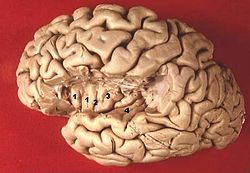Transverse temporal gyrus
Appearance
| Transverse temporal gyrus | |
|---|---|
 Section of brain showing upper surface of temporal lobe. ("Transverse temporal gyri" visible at center left.) | |
 Human brain view on transverse temporal and insular gyri (gyri temporales transversi are #4) | |
| Details | |
| Part of | Temporal lobe |
| Parts | Primary auditory cortex |
| Artery | Middle cerebral |
| Identifiers | |
| Latin | gyri temporales transversi |
| NeuroNames | 1520 |
| TA98 | A14.1.09.140 |
| TA2 | 5491 |
| FMA | 72016 |
| Anatomical terms of neuroanatomy | |
The transverse temporal gyri (also called Heschl's gyri or Heschl's convolutions) are found in the area of primary auditory cortex buried within the lateral sulcus of the human brain, occupying Brodmann areas 41 & 42. It is the first cortical structure to process incoming auditory information. Anatomically, the transverse temporal gyri are distinct in that they run mediolaterally (towards the center of the brain), rather than front to back as all other temporal lobe gyri run.
The transverse temporal gyri are active during auditory processing under fMRI for tone and semantic tasks. [citation needed]
The Heschl's gyri are named after Richard L. Heschl.
References
Wikimedia Commons has media related to Transverse temporal gyrus.
